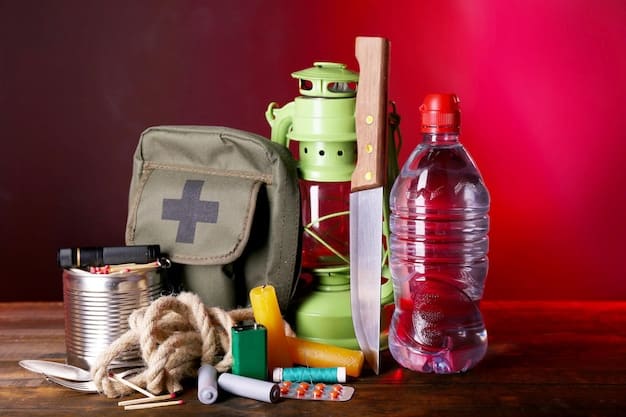Hurricane Season 2025: A Comprehensive Prep Guide for US Residents

Preparing for the 2025 hurricane season is crucial for US residents in vulnerable areas, involving creating a detailed plan, assembling emergency kits, securing your home, staying informed about weather updates, and understanding evacuation routes.
The 2025 hurricane season is approaching, and for residents across the US, particularly those in coastal regions, now is the time to take proactive steps. This comprehensive guide, **How to Prepare for the 2025 Hurricane Season: A Comprehensive Guide for US Residents**, offers practical advice and essential strategies to ensure your safety and protect your property.
Understanding Hurricane Risks in the US
Hurricanes pose a significant threat to many parts of the United States, bringing destructive winds, torrential rain, and dangerous storm surges. Understanding the specific risks in your area is the first step in effective hurricane preparation.
Assessing Your Regional Vulnerability
Different regions of the US face varying levels of hurricane risk. The Atlantic and Gulf Coasts are particularly vulnerable, but even inland areas can experience hurricane-related flooding and wind damage. Research your area’s history of hurricanes and consult FEMA’s flood maps to understand your specific vulnerability.
Understanding Hurricane Categories and Impacts
The Saffir-Simpson Hurricane Wind Scale categorizes hurricanes from 1 to 5 based on sustained wind speeds. Each category corresponds to a range of potential damage. Category 1 hurricanes can damage roofs and cause power outages, while Category 5 hurricanes can cause catastrophic damage. Knowing the scale helps you understand the potential impact in your area.
- Category 1: Minimal damage to roofs, gutters, and power outages.
- Category 3: Significant damage; mobile homes destroyed, flooding inland.
- Category 5: Catastrophic damage; most buildings severely damaged or destroyed, widespread flooding.
Ultimately, understanding the hurricane risks specific to your area empowers you to take targeted and effective preparation measures for the 2025 hurricane season.
Creating a Comprehensive Hurricane Preparedness Plan
A well-thought-out hurricane preparedness plan is your roadmap to safety and security. This plan should outline your family’s evacuation strategy, communication methods, and emergency resources.

Developing an Evacuation Strategy
If you live in an evacuation zone, knowing your evacuation route and destination is crucial. Identify multiple routes in case one is blocked. Pre-arrange a meeting place with family members in case you are separated during the evacuation.
Establishing Communication Protocols
During a hurricane, communication networks may be disrupted. Establish a family communication plan, including an out-of-state contact person who can serve as a central point of contact. Designate a meeting place if local communication fails.
- Identify primary and secondary evacuation routes.
- Establish a communication plan with a designated out-of-state contact.
- Ensure everyone knows the location of emergency shelters.
Having a comprehensive hurricane preparedness plan ensures that you and your family are ready to act quickly and confidently when a hurricane threatens.
Assembling an Emergency Hurricane Kit
An emergency kit is a collection of essential supplies that will help you survive for several days in the aftermath of a hurricane. Having a well-stocked kit can make a significant difference when resources are scarce.
Essential Supplies for Your Kit
Your emergency kit should include water, non-perishable food, a first-aid kit, a flashlight, a battery-powered radio, and extra batteries. Consider the specific needs of your family members, including medications, baby supplies, and pet food.
Maintaining and Updating Your Kit
Regularly check the expiration dates of food and medications in your emergency kit. Replace any items that have expired. Also, update your kit to reflect any changes in your family’s needs.

- Water: At least one gallon per person per day for several days.
- Non-perishable food: Canned goods, energy bars, dried fruits, and nuts.
- First-aid kit: Bandages, antiseptic wipes, pain relievers, and any prescription medications.
- Flashlight and battery-powered radio: With extra batteries.
Assembling and maintaining an emergency hurricane kit provides a safety net, ensuring you have the necessary resources to weather the storm.
Securing Your Home Against Hurricane Damage
Protecting your home from hurricane damage involves reinforcing vulnerable areas and taking preventive measures to minimize potential losses.
Protecting Windows and Doors
Windows and doors are often the weakest points in a home during a hurricane. Install hurricane shutters or reinforce windows with plywood. Ensure that doors are properly sealed and reinforced.
Reinforcing Your Roof and Structure
A strong roof is crucial during a hurricane. Consider reinforcing your roof with hurricane straps or clips. Trim trees and shrubs around your home to prevent them from falling and causing damage. Clear gutters and downspouts to prevent water damage.
- Install hurricane shutters or plywood over windows.
- Reinforce doors with deadbolts and bracing.
- Trim trees and clear gutters.
Securing your home against hurricane damage reduces the risk of costly repairs and provides a safer shelter during the storm.
Staying Informed During a Hurricane
Staying informed about weather updates and official advisories is critical during a hurricane. Timely information can help you make informed decisions and take appropriate actions.
Monitoring Weather Updates
Monitor weather updates from reliable sources, such as the National Hurricane Center (NHC) and local news channels. Pay attention to hurricane warnings and advisories. Understand the projected path and intensity of the storm.
Using Emergency Alert Systems
Sign up for emergency alert systems in your area. These systems provide timely notifications about hurricane threats, evacuation orders, and emergency resources. Familiarize yourself with the Wireless Emergency Alerts (WEA) system, which sends alerts to your mobile phone.
Remaining informed during a hurricane enhances your safety by enabling you to respond promptly to changing conditions and official directives.
Understanding Post-Hurricane Recovery and Insurance
Preparing for the aftermath of a hurricane is as important as preparing for the storm itself. Understanding the recovery process and your insurance coverage can ease the challenges that follow.
Documenting Damage and Filing Insurance Claims
After a hurricane, document any damage to your property with photographs and videos. Contact your insurance company as soon as possible to file a claim. Keep detailed records of all communication with your insurance company.
Accessing Resources and Assistance
Familiarize yourself with local and federal resources available to hurricane survivors. FEMA provides assistance with housing, medical expenses, and other essential needs. Non-profit organizations also offer support services to help you recover.
- Document all damage with photos and videos.
- Contact your insurance company promptly.
- Register with FEMA for assistance if needed.
Preparing for post-hurricane recovery ensures that you can navigate the aftermath effectively and access the support you need to rebuild your life.
| Key Point | Brief Description |
|---|---|
| ⚠️ Understand Risks | Assess vulnerability and hurricane categories. |
| 🏠 Secure Home | Protect windows, doors, and reinforce the roof. |
| 🎒 Emergency Kit | Assemble essential supplies for several days. |
| 📣 Stay Informed | Monitor weather updates and emergency alerts. |
Frequently Asked Questions (FAQ)
▼
The first steps include assessing your area’s risk, creating an evacuation plan, and assembling an emergency kit with essential supplies.
▼
Protect your home by reinforcing windows and doors with shutters or plywood, securing the roof, and trimming nearby trees.
▼
An emergency kit should contain water, non-perishable food, a first-aid kit, flashlight, radio, batteries, and necessary medications.
▼
Reliable sources include the National Hurricane Center (NHC), local news channels, and emergency alert systems in your area.
▼
Document all damage, file an insurance claim promptly, and register with FEMA for assistance if needed to ensure a smooth recovery.
Conclusion
Preparing for the 2025 hurricane season is a crucial responsibility for US residents in vulnerable areas. By understanding the risks, creating a comprehensive plan, assembling an emergency kit, securing your home, staying informed, and understanding recovery processes, you can significantly enhance your safety and resilience.






